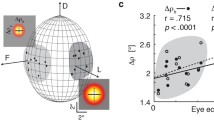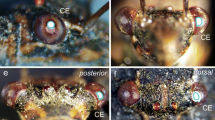Summary
The drone retina is composed of two types of cells: the photoreceptors in which no glycogen has been detected by electron microscopy and the glial cells which have abundant glycogen stores. 15 min light stimulation of the retina of intact drones caused a 33% decrease of the glycogen content, which recovered with more prolonged stimulation. Photostimulation of the retina for more than 15 min led to an increase of incorporation of3H-glucose into glycogen. Since apparently both synthesis and degradation increase (when stimulation lasts for more than 15 min) the results demonstrate an increase of glycogen turnover.
Similar content being viewed by others
References
Autrum H, Tscharntke H (1962) Der Sauerstoffverbrauch der Insektenretina im Licht und im Dunkeln. Z Vergl Physiol 45:695–710
Baumann F (1974) Electrophysiological properties of the honeybee retina. In: Horridge GA (ed) The compound eye and vision of insects. Clarendon Press, Oxford, pp 53–74
Baumann F, Mauro A (1973) Effect of hypoxia on the change in membrane conductance evoked by illumination in arthropod photoreceptors. Nature 244:146–148
Bertrand D (1974) Etudes des propriétés électrophysiologiques des cellules pigmentaires de la rétine du faux bourdon. Thèse No 1650, Geneva University
Bertrand D, Fuortes G, Muri R (1979) Pigment transformation and electrical responses in retinula cells of droneApis mellifera. J Physiol (Lond) 296:431–441
Brandt NR, Huber RE (1979) Carbohydrate utilization in the thoraces of honeybees (Apis mellifera) during early times of flight. J Insect Physiol 25:483–486
Chan TM, Exton JH (1976) A rapid method for the determination of glycogen content and radioactivity in small quantities of tissue or isolated hepatocytes. Anal Biochem 71:96–105
Coles JA, Tsacopoulos M (1979) K+ activity in photoreceptors, glial cells and extracellular space in the drone retina: changes during photostimulation. J Physiol (Lond) 290:525–549
Coles JA, Tsacopoulos M (1981) Ionic and possible metabolic interactions between sensory neurones and glial cells in the retina of the honeybee drone. J Exp Biol 95:75–92
Devos P, Hers HG (1979) A molecular order in the synthesis and degradation of glycogen in the liver. Eur J Biochem 99:161–167
Evêquoz V, Deshusses J, Tsacopoulos M (1978) The effect of photostimulation on the glycogen turnover in the retina of the honey-bee drone. Experientia 34:897
Hamdorf K, Kaschef AH (1964) Der Sauerstoffverbrauch der Facettenaugen vonCalliphora erythrocephala in Abhängigkeit von der Temperatur und dem Ionenmilieu. Z Vergl Physiol 48:251–265
Jöngbloed J, Wiersma CAG (1935) Der Stoffwechsel der Honigbiene während des Fliegens. Z Vergl Physiol 21:519–533
Langer H (1962) Die Wirkung von Licht auf den chemischen Grundaufbau des Auges vonCalliphora erythrocephala Meigen. J Insect Physiol 4:283–303
Lowry O, Rosenbrough NJR, Farr AL, Randall RJ (1951) Protein measurement with the Folin Phenol Reagent. J Biol Chem 193:265–275
Nahorski SR, Rogers KH (1972) An enzymatic fluorometric micromethod for determination of glycogen. Anal Biochem 49:492–497
Pentreath VW, Kai-Kai MA (1982) Significance of the potassium signal from neurones to glial cells. Nature 295:59–61
Perrelet A (1970) The fine structure of the retina of the honeybee drone. Z Zellforsch Mikrosk Anat 108:530–562
Perrelet A (1972) Protein synthesis in the visual cells of the honeybee drone as studied with electron microscope radioautography. J Cell Biol 55:595–605
Sacktor B, Wormser-Shavit E (1966) Regulation of metabolism in working muscle in vivo. J Biol Chem 241:624–631
Sacktor B (1975) Biochemistry of insect flight. In: Candy DJ, Kilby BA (eds) Insect biochemistry and function. Chapman and Hall, London, pp 3–88
Salem RD, Hammerschlag R, Bracho H, Orkand RK (1975) Influence of potassium ions on accumulation and metabolism of14C glucose by glial cells. Brain Res 86:499–503
Spring JH, Matthews JR, Downer RGH (1977) Fate of glucose in haemolymph of the American cockroach,Periplaneta americana. J Insect Physiol 23:525–529
Tsacopoulos M, Evêquoz V (1980) L'effet de la stimulation photique sur le métabolisme du glycogène intrarétinien. Klin Monatsbl Augenheilkd 176:519–521
Tsacopoulos M, Poitry S (1982) Kinetics of oxygen consumption after a single flash of light in photoreceptors of the drone (Apis mellifera). J Gen Physiol 80:19–55
Tsacopoulos M, Poitry S, Borsellino A (1981a) Diffusion and consumption of oxygen in the superfused retina of the drone (Apis mellifera) in darkness. J Gen Physiol 77:601–628
Tsacopoulos M, Poitry S, Borsellino A (1981b) Oxygen consumption by drone photoreceptors in darkness and during repetitive stimulation with light flashes. In: Kovách AGB, Dóra E, Kessler M, Silver IA (eds) Advances Physiol Sci oxygen transport to tissue, vol 25. Pergamon Press, Akadémiai Kiadó, Budapest, pp 235–236
Weber KW, Zinkler D (1973) Enzyme and phospholopid patterns in the compound eye of insects. In: Langer H (ed) Biochemistry and physiology of visual pigments. Springer, Berlin Heidelberg New York, pp 327–333
Author information
Authors and Affiliations
Rights and permissions
About this article
Cite this article
Evêquoz, V., Stadelmann, A. & Tsacopoulos, M. The effect of light on glycogen turnover in the retina of the intact honeybee drone (Apis mellifera). J. Comp. Physiol. 150, 69–75 (1983). https://doi.org/10.1007/BF00605289
Accepted:
Issue Date:
DOI: https://doi.org/10.1007/BF00605289




